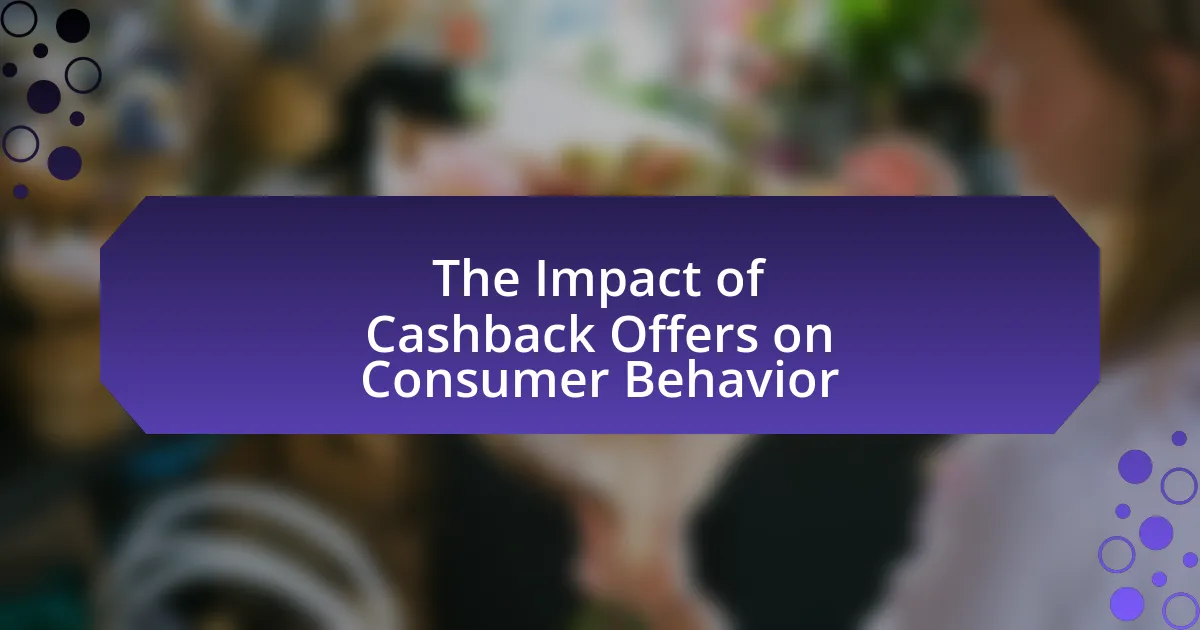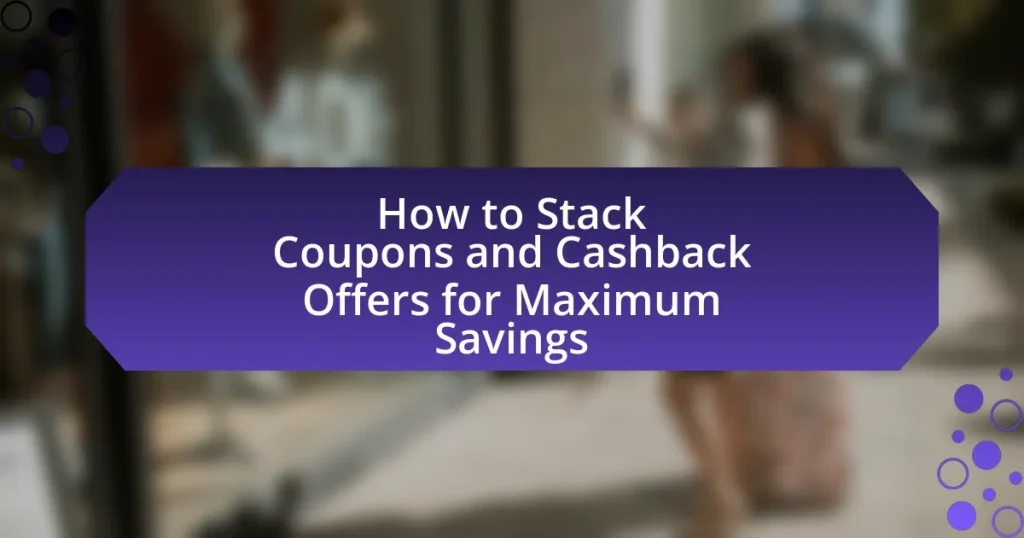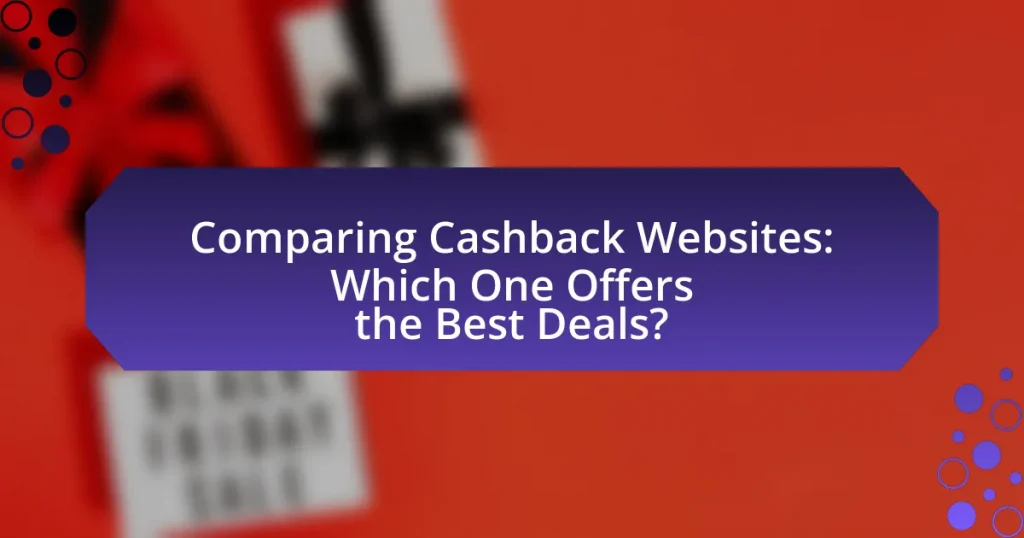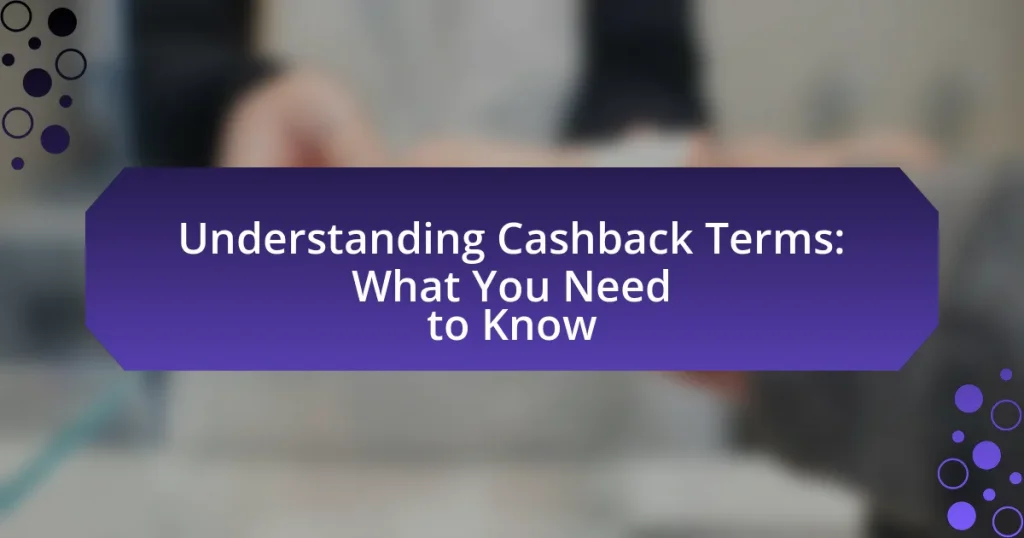Cashback offers are promotional incentives provided by retailers and financial institutions that return a percentage of the purchase price to consumers, influencing their spending behavior and loyalty. This article explores various types of cashback offers, including flat-rate, tiered, and promotional cashback, and examines how these incentives affect consumer purchasing frequency, spending habits, and brand loyalty. Additionally, it discusses the psychological factors that drive consumer responses to cashback offers, the common terms and conditions associated with them, and the long-term implications for both consumers and businesses. The effectiveness of cashback programs in competitive marketing strategies and best practices for implementation are also analyzed, providing insights into their impact on consumer behavior.

What are Cashback Offers and How Do They Work?
Cashback offers are promotional incentives provided by retailers or financial institutions that return a percentage of the purchase price to the consumer after a transaction. These offers typically work by allowing customers to receive a rebate on their spending, either as a direct deposit, credit to their account, or as points redeemable for future purchases. For example, a retailer may offer a 5% cashback on purchases made with a specific credit card, meaning if a consumer spends $100, they receive $5 back. This mechanism encourages consumer spending and loyalty, as studies indicate that cashback incentives can significantly influence purchasing decisions and increase overall sales for businesses.
What types of cashback offers are available to consumers?
Consumers can access several types of cashback offers, including flat-rate cashback, tiered cashback, and promotional cashback. Flat-rate cashback provides a consistent percentage back on all purchases, such as 1.5% on every transaction. Tiered cashback offers varying percentages based on spending thresholds, for example, 1% on the first $1,000 spent and 2% on amounts above that. Promotional cashback is often temporary, providing higher rates for specific categories or during limited-time events, like 5% back on groceries for a promotional period. These cashback structures incentivize consumer spending and influence purchasing decisions, as evidenced by studies showing that cashback offers can increase transaction frequency and average purchase amounts.
How do percentage-based cashback offers differ from fixed amount offers?
Percentage-based cashback offers provide a percentage of the purchase amount back to the consumer, while fixed amount offers provide a predetermined dollar amount regardless of the purchase size. For example, a percentage-based offer of 5% on a $100 purchase gives the consumer $5 back, whereas a fixed amount offer of $5 gives the same rebate regardless of whether the purchase is $50 or $200. This distinction affects consumer behavior, as percentage-based offers incentivize higher spending to maximize cashback, while fixed amount offers may appeal to budget-conscious consumers who prefer immediate, predictable savings.
What are the common terms and conditions associated with cashback offers?
Common terms and conditions associated with cashback offers typically include eligibility criteria, minimum purchase requirements, and specific timeframes for claiming the cashback. Eligibility criteria often specify that the offer is available only to certain customers, such as new users or members of a loyalty program. Minimum purchase requirements dictate the minimum amount a customer must spend to qualify for the cashback. Timeframes for claiming cashback usually outline a deadline by which the purchase must be made and a period within which the cashback must be redeemed, often ranging from a few weeks to several months. Additionally, exclusions may apply, such as specific products or services that do not qualify for cashback, and limitations on the total cashback amount that can be earned.
Why do businesses implement cashback offers?
Businesses implement cashback offers to incentivize consumer purchases and enhance customer loyalty. By providing a percentage of the purchase price back to the consumer, businesses can stimulate sales, attract new customers, and encourage repeat transactions. Research indicates that cashback offers can increase consumer spending by as much as 30%, as they create a perception of value and savings. Additionally, cashback programs can help businesses gather valuable data on consumer preferences and spending habits, allowing for more targeted marketing strategies.
How do cashback offers influence customer acquisition and retention?
Cashback offers significantly enhance customer acquisition and retention by providing immediate financial incentives that attract new customers and encourage repeat purchases. Research indicates that 79% of consumers are more likely to engage with brands that offer cashback rewards, demonstrating their effectiveness in drawing in new clientele. Furthermore, cashback programs foster loyalty; customers who receive cashback are 30% more likely to return for future purchases, as they perceive added value in their transactions. This dual impact of attracting new customers while retaining existing ones underscores the strategic importance of cashback offers in consumer behavior.
What role do cashback offers play in competitive marketing strategies?
Cashback offers serve as a strategic tool in competitive marketing by incentivizing consumer purchases and enhancing brand loyalty. These offers attract price-sensitive customers, encouraging them to choose one brand over another, thereby increasing market share. Research indicates that 79% of consumers are more likely to shop at retailers that offer cashback rewards, demonstrating their effectiveness in driving sales. Additionally, cashback programs can differentiate a brand in a crowded marketplace, fostering repeat business and customer retention, which is crucial for long-term profitability.
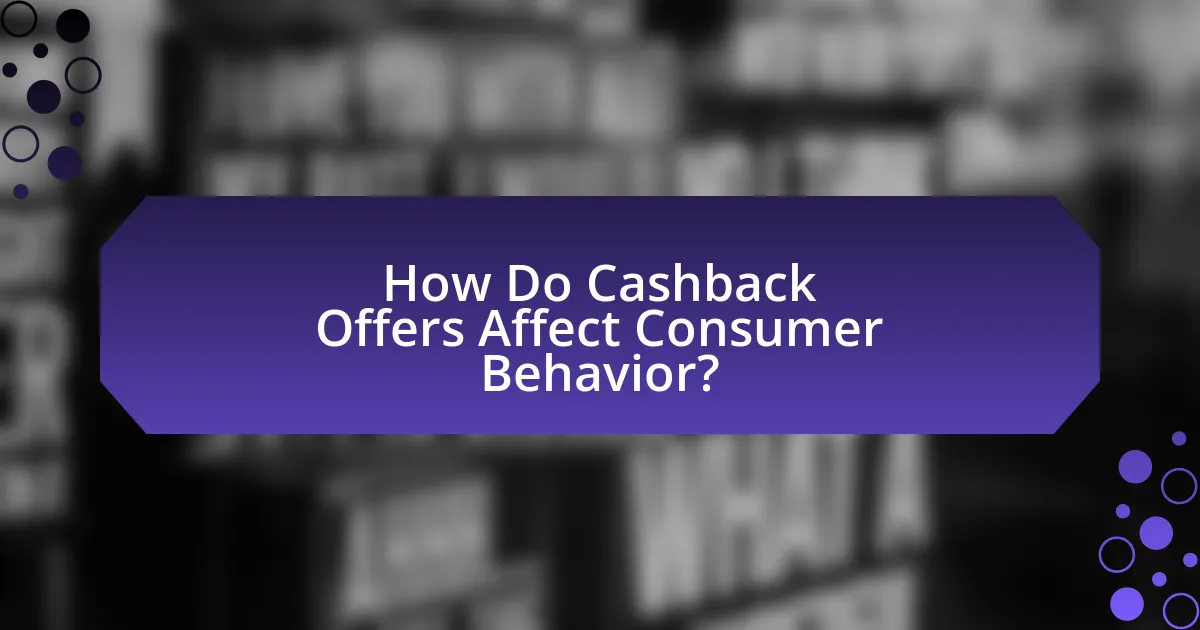
How Do Cashback Offers Affect Consumer Behavior?
Cashback offers significantly influence consumer behavior by incentivizing purchases and increasing spending. Research indicates that consumers are more likely to buy products when they perceive a financial benefit, such as receiving a percentage of their spending back. A study published in the Journal of Marketing Research found that cashback promotions can lead to a 20% increase in purchase frequency among consumers, as they are motivated by the prospect of saving money. Additionally, cashback offers can create brand loyalty, as consumers tend to return to brands that provide these incentives, further reinforcing their purchasing habits.
What psychological factors influence consumer responses to cashback offers?
Psychological factors influencing consumer responses to cashback offers include perceived value, loss aversion, and social proof. Perceived value refers to the consumer’s assessment of the benefits received from the cashback relative to the cost incurred; higher perceived value increases the likelihood of purchase. Loss aversion, a concept from behavioral economics, suggests that consumers prefer to avoid losses rather than acquire equivalent gains, making cashback offers appealing as they mitigate the perceived risk of spending. Social proof, the influence of others’ behaviors on individual choices, can enhance the attractiveness of cashback offers when consumers observe peers benefiting from such promotions. Research by Thaler and Sunstein in “Nudge: Improving Decisions About Health, Wealth, and Happiness” supports these psychological principles, demonstrating how they shape consumer behavior in financial decision-making contexts.
How does perceived value impact consumer decision-making?
Perceived value significantly influences consumer decision-making by shaping their assessment of a product’s worth relative to its cost. When consumers perceive high value in a product, they are more likely to make a purchase, as they believe the benefits outweigh the price. Research indicates that 70% of consumers are willing to pay more for products they perceive as high quality, demonstrating that perceived value directly correlates with purchasing behavior. Additionally, cashback offers enhance perceived value by providing consumers with a tangible benefit, further incentivizing their decision to buy.
What role does urgency play in the effectiveness of cashback offers?
Urgency significantly enhances the effectiveness of cashback offers by creating a time-sensitive incentive for consumers to make a purchase. When consumers perceive a limited time to take advantage of a cashback offer, they are more likely to act quickly, driven by the fear of missing out on savings. Research indicates that urgency can increase conversion rates; for instance, a study by Cialdini (2009) highlights that scarcity and urgency are powerful motivators in consumer decision-making. This psychological trigger leads to a higher likelihood of impulse buying, as consumers prioritize immediate gratification over delayed benefits. Thus, urgency plays a crucial role in amplifying the appeal and success of cashback promotions.
How do cashback offers impact purchasing frequency and spending habits?
Cashback offers significantly increase purchasing frequency and alter spending habits by incentivizing consumers to make more frequent purchases to earn rewards. Research indicates that consumers are more likely to buy products they might not have considered otherwise when a cashback incentive is present, leading to an increase in overall spending. For instance, a study by the Journal of Marketing Research found that cashback promotions can lead to a 20% increase in purchase frequency among targeted consumers. This behavior is driven by the perceived value of receiving money back, which encourages consumers to prioritize spending in categories where cashback is offered, ultimately reshaping their purchasing patterns.
What trends have emerged in consumer spending due to cashback incentives?
Cashback incentives have led to increased consumer spending, particularly in categories such as online shopping and everyday purchases. Research indicates that consumers are more likely to make impulsive purchases when they know they will receive a percentage back, with a study by the National Retail Federation showing that 79% of consumers are more inclined to shop at retailers offering cashback. Additionally, cashback programs have encouraged brand loyalty, as consumers tend to return to brands that provide these incentives, resulting in higher overall spending per customer.
How do cashback offers affect brand loyalty among consumers?
Cashback offers significantly enhance brand loyalty among consumers by providing tangible financial incentives for repeat purchases. Research indicates that consumers are more likely to remain loyal to brands that offer cashback rewards, as these incentives create a sense of value and appreciation. A study published in the Journal of Marketing Research found that 70% of consumers reported increased loyalty to brands that provided cashback offers, highlighting the effectiveness of such promotions in fostering long-term relationships. Additionally, cashback programs encourage consumers to choose specific brands over competitors, reinforcing brand preference and loyalty through consistent rewards.
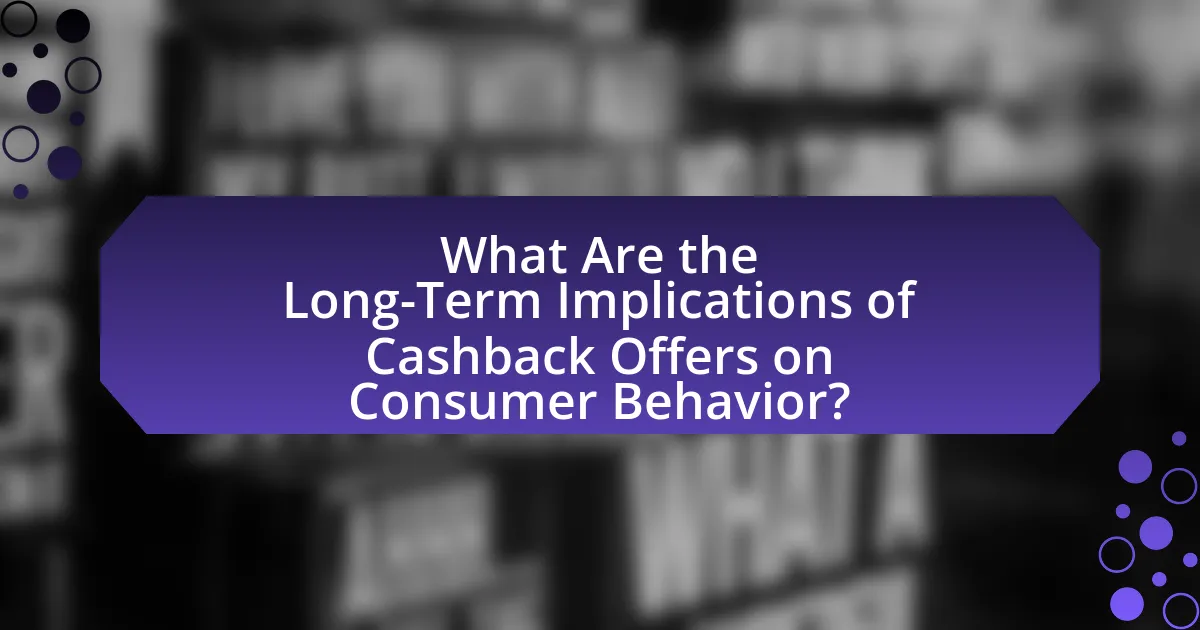
What Are the Long-Term Implications of Cashback Offers on Consumer Behavior?
Cashback offers significantly influence long-term consumer behavior by fostering brand loyalty and altering purchasing habits. Over time, consumers who regularly engage with cashback programs tend to prioritize brands that provide these incentives, leading to increased repeat purchases. Research indicates that 79% of consumers are more likely to shop at retailers that offer cashback rewards, demonstrating a clear preference for brands that enhance their purchasing experience through financial incentives. Additionally, cashback offers can encourage consumers to spend more per transaction, as they perceive greater value in their purchases, which can lead to a shift in overall spending patterns. This behavioral change is supported by data showing that consumers participating in cashback programs often increase their average transaction size by 20-30%. Thus, the long-term implications of cashback offers include enhanced customer loyalty, altered spending behaviors, and a preference for brands that provide financial rewards.
How do cashback offers influence consumer expectations over time?
Cashback offers significantly influence consumer expectations over time by creating a perception of value and encouraging repeat purchases. As consumers experience the benefits of cashback, they begin to anticipate similar rewards in future transactions, leading to increased loyalty towards brands that provide these incentives. Research indicates that 79% of consumers are more likely to shop at retailers that offer cashback, demonstrating that these offers shape purchasing behavior and expectations. Over time, this consistent reinforcement of value can lead consumers to expect cashback as a standard feature in their shopping experiences, altering their overall perception of pricing and value in the marketplace.
What happens when consumers become accustomed to cashback offers?
When consumers become accustomed to cashback offers, their purchasing behavior often shifts towards seeking out these promotions more aggressively. This habituation can lead to increased brand loyalty, as consumers may prefer retailers that consistently provide cashback incentives. Research indicates that habitual exposure to cashback offers can create a perception of value, making consumers more likely to prioritize purchases from brands that offer such rewards. For instance, a study by the Journal of Marketing Research found that consumers who regularly engage with cashback programs tend to increase their overall spending by 20% compared to those who do not utilize these offers. This demonstrates that familiarity with cashback incentives can significantly influence consumer behavior and spending patterns.
How do cashback offers affect consumer trust in brands?
Cashback offers enhance consumer trust in brands by providing tangible financial incentives that demonstrate a brand’s commitment to customer satisfaction. When consumers receive cashback, they perceive the brand as more reliable and customer-focused, which fosters loyalty. Research indicates that 73% of consumers are more likely to trust a brand that offers cashback rewards, as these offers create a sense of value and reciprocity. This trust is further reinforced when cashback offers are straightforward and easy to redeem, leading to positive brand experiences that encourage repeat purchases.
What best practices should businesses follow when implementing cashback offers?
Businesses should ensure clarity and simplicity in their cashback offers to maximize consumer engagement and satisfaction. Clear communication of the terms and conditions, including eligibility, redemption process, and expiration dates, helps prevent confusion and builds trust. Research indicates that 70% of consumers are more likely to participate in cashback programs when the rules are straightforward (Source: Nielsen). Additionally, businesses should leverage data analytics to tailor cashback offers to specific customer segments, enhancing relevance and effectiveness. A study by McKinsey found that personalized promotions can increase customer response rates by up to 30%. Finally, promoting cashback offers through multiple channels, such as social media and email marketing, can significantly boost visibility and participation, as 60% of consumers report discovering offers through these platforms (Source: Statista).
How can businesses measure the effectiveness of their cashback programs?
Businesses can measure the effectiveness of their cashback programs by analyzing key performance indicators (KPIs) such as redemption rates, customer retention rates, and overall sales growth attributed to the program. For instance, a high redemption rate indicates that customers are engaging with the cashback offer, while increased customer retention suggests that the program successfully encourages repeat purchases. Additionally, tracking sales growth during the cashback promotion period compared to previous periods provides concrete evidence of the program’s impact. According to a study by the Journal of Marketing Research, cashback offers can lead to a 20% increase in customer spending, reinforcing the effectiveness of such programs in driving consumer behavior.
What strategies can enhance the appeal of cashback offers to consumers?
To enhance the appeal of cashback offers to consumers, companies can implement tiered cashback structures that reward higher spending with increased percentages. This strategy incentivizes consumers to spend more to reach higher cashback tiers, effectively increasing overall sales. Research indicates that tiered rewards can lead to a 20% increase in consumer spending, as consumers are motivated by the prospect of maximizing their rewards. Additionally, promoting limited-time offers can create urgency, encouraging quicker purchasing decisions. By combining these strategies, businesses can significantly boost the attractiveness of their cashback programs.
